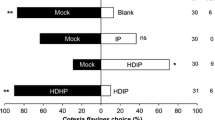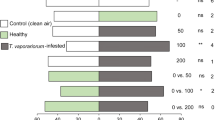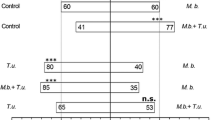Abstract
Several studies have shown that herbivore-induced plant volatiles act directly on herbivores and indirectly on their natural enemies. However, little is known about the effect of herbivore damage on resistant and susceptible plant cultivars and its effect on their natural enemies. Thus, the aim of this study was to evaluate the attraction of the herbivorous pentatomid bug Euschistus heros and its egg parasitoid Telenomus podisi to two resistant and one susceptible soybean cultivars with different types of damage (herbivory, herbivory+oviposition, and oviposition). In a Y-tube olfactometer, the parasitoids were attracted to herbivory and herbivory+oviposition damaged soybean plants when compared to undamaged soybean plants for the resistant cultivars, but did not show preference for the susceptible cultivar Silvânia in any of the damage treatments. The plant volatiles emitted by oviposition-damaged plants in the three cultivars did not attract the egg parasitoid. In four-arm-olfactometer bioassays, E. heros females did not show preference for odors of damaged or undamaged soybean plants of the three cultivars studied. The Principal Response Curves (PRC) analysis showed consistent variability over time in the chemical profile of volatiles between treatments for the resistant cultivar Dowling. The compounds that most contributed to the divergence between damaged soybean plants compared to undamaged plants were (E,E)-α-farnesene, methyl salicylate, (Z)-3-hexenyl acetate, and (E)-2-octen-1-ol.








Similar content being viewed by others
References
Bartlett, R. 2008. Negative interactions between chemical resistance and predators affect fitness in soybeans. Ecol. Entomol. 33:673–678.
Borges, M., Schmidt, F. G. V., Sujii, E. R., Medeiros, M. A., Mori, K., Zarbin, P. H. G., and Ferreira, J. T. B. 1998. Field responses of stink bugs to the natural and synthetic pheromone of the Neotropical brown stink bug, Euschistus heros (Heteroptera: Pentatomidae). Physiol. Entomol. 23:202–207.
Carrão-Panizzi, M. C. and Kitamura, K. 1995. Isoflavone content in Brazilian soybean cultivars. Breed. Sci. 45:295–300.
Chen, M. S. 2008. Inducible direct plant defense against insect herbivores: A review. Insect Science 15:101–114.
Colazza, S., Fucarino, A., Peri, E., Salerno, G., Conti, E., and Bin, F. 2004a. Insect oviposition induces volatile emission in herbaceous plants that attracts egg parasitoids. J. Exp. Biol. 207:47–53.
Colazza, S., McElfresh, J. S., and Millar, J. G. 2004b. Identification of volatile synomones, induced by Nezara viridula feeding and oviposition on bean spp., that attract the egg parasitoid Trissolcus basalis. J. Chem. Ecol. 30:945–964.
Cortesero, A. M., Stapel, J. O., and Lewis, W. J. 2000. Understanding and manipulating plant attributes to enhance biological control. Biol. Control 17:35–49.
D’alessandro, M., Held, M., Triponez, Y., and Turlings, T. C. J. 2006. The role of indole and other shikimic acid derived maize volatiles in the attraction of two parasitic wasps. J. Chem. Ecol. 32:2733–2748.
D’alessandro, M., Brunner, V., Von Mérey, G., and Turlings, T. C. J. 2009. Strong attraction of the parasitoid Cotesia marginiventris towards minor volatile compounds of maize. J. Chem. Ecol. 35:999–1008.
De Moraes, C. M., Mescher, M. C., and Tumlinson, J. H. 2001. Caterpillar-induced nocturnal plant volatiles repel conspecific females. Nature 410:577–580.
Dicke, M. 1999. Are herbivore-induced plant volatiles reliable indicators of herbivore identity to foraging carnivorous arthropods? Entomol. Exp. Appl. 91:131–142.
Fehr, W. R., Caviness, C. E., Burmood, D. T., and Pennington, J. S. 1971. Stage of development descriptions for soybeans, Glycine max (L.) Merrill. Crop Science 11:929–931.
Fritzsche Hoballah, M. E., and Turlings, T. C. J. 2001. Experimental evidence that plants under caterpillar attack may benefit from attracting parasitoids. Evol. Ecol. Res. 3:553–565.
Gatehouse, J. A. 2002. Plant resistance towards insect herbivores: A dynamic interaction. New Phytol. 156: 145–169.
Green, R. H. 1993. Application of repeated measures designs in environmental impact and monitoring studies. Aust. J. Ecol. 18:81–98.
Heil, M. 2008. Indirect defence via tritrophic interactions. New. Phytol. 178:41–61.
Hilker, M. and Meiners, T. 2006. Early herbivore alert: Insect eggs induce plant defense. J. Chem. Ecol. 32: 1379–1397.
Hoffmann-Campo, C. B., Harborne, J. B., and McCaffery, A. R. 2001. Pre-ingestive and post-ingestive effects of soya bean extracts and rutin on Trichoplusia ni growth. Entomol. Exp. Appl. 98:181–194.
Hurlbert, S. H. 1984. Pseudoreplication and the design of ecological field experiments. Ecol. Monogr. 54:187–211.
Jorge, L. A. C., Laumann, R. A., Borges, M., Moraes, M. C. B., Cruz, R. A., Milare, B. N., and Palhares, L. 2005. Software para avaliação do comportamento de insetos. São Carlos, SP. Embrapa Instrumentação Agropecuária. Circular Técnica, Vol. 30, 7p.
Kaloshian, I. and Walling, L. L. 2005. Hemipterans as plant pathogens. Annu. Rev. Phytopathol. 43:491–521.
Laumann R. A., Farias Neto, A. L., Blassioli-Moraes, M. C., Silva, A. P., Vieira, C. R., Moraes, S. V. P., Hoffman-Campo, C. B., and Borges, M. 2008. Dinâmica populacional de percevejos (Hemiptera:Pentatomidae) em diferentes genótipos de soja. In: IX Simpósio Nacional Cerrado; II Simpósio Internacional Savanas Tropicais, Brasília, DF. Desafios e estratégias para o equilíbrio entre sociedade, agronegócio e recursos naturais: anais. Planaltina, DF: Embrapa Cerrados, http://www.cpac.embrapa.br/download/747/t
Li, Y., Hill, C. B., and Hartman, G. L. 2004. Effect of three resistant soybean genotypes on the fecundity, mortality and maturation of soybean aphid (Homoptera: Aphididae). J Econ. Entomol. 97:1106–1111.
Li, Y., Zou, J., Li, M., Bilgin, D. D., Vodkin, L.O., Hartman, G. L., and Clough, S. J. 2008. Soybean defense responses to the soybean aphid. New. Phytol. 179:185–195.
Lin, C., Shen, B., Xu, Z., Köllner, T. G., Degenhardt, J., and Dooner, H. 2008. Characterization of monoterpene synthase gene tps 26, the ortholog of a gene induced by insect herbivory in maize. Plant Physiol. 146:940–951.
McPherson, R. M. and Buss, G. R. 2007. Evaluation lepidopteran defoliation resistance in soybean breeding lines containing the stink bug (Hemipetra: Pentatomidae) resistance IAC100 cultivar in their pedigrees. J. Econ. Entomol. 100:962–968.
Moraes, M. C. B., Laumann, R. A., Pires, C. S. S., Sujii, E. R., and Borges, M. 2005. Induced volatiles in soybean and pigeon pea plants artificially infested with the Neotropical brown stink bug, Euschistus heros, and their effect on the egg parasitoid, Telenomus podisi. Entomol. Exp. Appl. 115:227–237.
Moraes, M. C. B., Pareja, M., Laumann, R. A., Hoffmann-Campo, C. B., and Borges, M. 2008. Response of the parasitoid Telenomus podisi to induced volatiles from soybean damaged by stink bug herbivory and oviposition. J. Plant. Int. 3:1742–1756.
Pareja, M., Mohib, A., Birkett, A. M., Dufour, S., and Glinwood, R. T. 2009. Multivariate statistics coupled to generalized linear models reveal complex use of chemicals cues by a parasitoid. Anim. Behav. 77:901–909.
Piubelli, G. C., Hoffmann-Campo, C. B., Arruda, I. C., Franchini, J. C., and Lara, F. M. 2003. Flavonoid increase in soybean as a response to Nezara viridula injury and its effects on insect-feeding preference. J. Chem. Ecol. 29:1232–1232.
Piubelli, G. C., Hoffmann-Campo, C. B., Moscardi, F., Miyakubo, S. H., and Oliveira, M. C. N. 2005. Are chemical compounds important for soybean resistance to Anticarsia gemmatalis? J. Chem. Ecol. 31: 1509–1525.
Poelman, E. H., Van Loon, J. J. A., Van Dam, N. M., Vet, L. E. M., and Dicke, M. 2010. Herbivore-induced plant responses in Brassica oleracea prevail over effects of constitutive resistance and result in enhanced herbivore attack. Ecol. Entomol. 35:240–247.
Price, P. 1997. Insect Ecology. 3rd edn. P. 874. John Wiley & Sons, New York.
Rao, K. V., Chattopabhyay, S. K., and Chandrasekhara Reddy, G. 1990. Flavonoids with mosquito larval toxicity. J. Agric. Food. Chem. 38:1427–1430.
Rasmann, S. and Turlings, T. C. J. 2008. First insights into specificity of belowground tritrophic interactions. Oikos 117:362–369.
Sas Institute. 2001. SAS User’s Guide: Statistics, version 8.2, 6th edn. SAS Institute, Cary, NC.
Snoeren, T. A. L., Mumm, R., Poelman, E. H., Yang, Y., Pichersky, E., and Dicke, M. 2010. The herbivore-induced plant volatile methyl salicylate negatively affects attraction of the parasitoid Diadegma semiclausum. J. Chem. Ecol. 36:479–489.
ter Braak, C. J. F. and Šmilauer, P. 2002. CANOCO Reference Manual and User’s Guide to Canoco for Windows: Software for Canonical Community Ordination (version 4.5). Microcomputer Power, Ithaca, New York.
Thaler, J. S. 1999. Jasmonate-inducible plant defences cause increased parasitism of herbivores. Nature 399:686–688.
Torres, J. B., and Ruberson, J. R. 2005. Canopy and ground-dwelling predatory arthropods in commercial Bt and non-Bt cotton fields: patterns and mechanisms. Environ. Entomol. 34:1242–1256.
van den Brink, P. J., and ter Braak, C. J. F. 1999. Principal response curves: analysis of time dependent multivariate responses of biological community to stress. Environ. Toxicol. Chem. 18:138–148.
van den Brink, P. J., van den Brink, N. W., and ter Braak, C. J. F. 2003. Multivariate analysis of ecotoxicological data using ordination: demonstrations of utility on the basis of various examples. Aust. J. Ecotoxicol. 9:141–156.
Vet, L. E. M., Van Lenteren, J. C., Heymans, M., and Meelis, E. 1983. An airflow olfactometer for measuring olfactory responses of hymenopterous parasitoids and other small insects. Physiol. Entomol. 8:97–106.
Vet, L. E. M., De Jong, A. G., Franchi, E., and Papaj, D. R. 1998. The effect of complete versus incomplete information on odour discrimination in a parasitic wasp. Anim. Behav. 55:1271–1279.
von Ende, C. N. 1993. Repeated-measures analysis: growth and other time-dependent measures. pp. 113–137 in: S. Scheiner and J. Gurevitch (eds). Design and Analysis of Ecological Experiments. Chapman & Halland, New York.
Walling, L. L. 2000. The myriad plant responses to herbivores. J. Plant Growth Regul. 19:195–216.
Zar, J. H. 1998. Biostatistical Analysis. 1st edn. P. 929. Prentice Hall, London, UK.
Acknowledgements
We thank H. Santos and D. Tiburcio for helping with laboratory rearing of the insects, and Jeffrey Aldrich and Michael Birkett for providing synthetic standards. We are grateful to Dr. Mark Horn International Consultant at Embrapa Genetic Resources and Biotechnology, to Monika Hilker and Martin Pareja for comments that improved the manuscript and for revising the English. We also thank the Post-Graduate Animal Biology program of University of Brasília (UnB) for use of their facility. This work received financial support from the Brazilian Council for Scientific and Technological Development (CNPq) through a grant to Mirian F.F. Michereff, International Foundation for Science IFS, Distrito Federal Research Foundation (FAP-DF) and Brazilian Corporation of Agricultural Research (EMBRAPA).
Author information
Authors and Affiliations
Corresponding author
Rights and permissions
About this article
Cite this article
Michereff, M.F.F., Laumann, R.A., Borges, M. et al. Volatiles Mediating a Plant-Herbivore-Natural Enemy Interaction in Resistant and Susceptible Soybean Cultivars. J Chem Ecol 37, 273–285 (2011). https://doi.org/10.1007/s10886-011-9917-4
Received:
Revised:
Accepted:
Published:
Issue Date:
DOI: https://doi.org/10.1007/s10886-011-9917-4




